2011 Ski-Doo Real-World Review
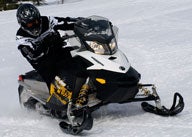
We take a second look at three sporty Ski-Doos
It was a Ski-Doo kind of day. Three of us rode full production models, one from each of the company’s sporting food group — the XRS, a full-on 800 ETEC powered racer replica of the snocrosser; an MXZ X package with the evolved 600 ETEC; and the newest “entry” TNT sportster highlighted by the surprisingly impressive 600 ACE four-stroke and eDrive. When we would stop for lunch, the only other snowmobilers we saw at the trailside pub had arrived by Ski-Doo, dresser sleds with packs and amenities. We had the new ones and appreciated the upgrades that had been made in recent years.
This Ski-Doo day was a chance for this snowmo-writer to grasp once again how privileged our world is and how we owe you careful reflection when we review sleds in the digital world of Snowmobile.com. This was a day where we had a “re-Doo” with key models in this manufacturer’s product line. The day would take us more than 100 miles over trails that varied from tight and challenging to miles of straight, wide-open super snow-ways. It gave us a chance to feel the product in the real world of every day snowmobiling, not the protective womb of a controlled “test” site, where manufacturers’ engineers and technicians carefully watch over and re-tune each unit after a media member’s brief, expert ride.
As media members it is easy to take this privileged test life and make more of it than really exists. The annual test ride and photo shoot, where we experience our first serious rides of the new products is fraught with deceit, much of it caused by our own egos. After all, what snowmobiler do you know who isn’t admittedly the best rider ever? We all are the best.
Over the decades of professionally test riding sleds beginning with the no longer with us brands such as Northway, Rupp, Skiroule and Moto-Ski, and, of course, the still with us Arctic Cat, Yamaha, Polaris, plus Ski-Doo, we have seen sleds from these events devolve from the most wonderful we’d ever ridden as pre-production or prototypical samples to something very much less. Some of the sleds we rode in the early days never made it from prototype to production as the companies that wanted to build them quit the snowmobile business or simply disappeared before the next season arrived. Not so Ski-Doo, this pioneer was Number One when this writer started reporting on the sport and, after loosing that status for a time, has come back strong thanks to innovative products like its REV models and a responsiveness to what snowmobilers want. The three sleds we rode exemplified that resurrection and “raison d’etre” for success.
These three production sleds gave us a chance to revisit something that we had known all along. What we ride in the annual pre-season test sessions at locations away from our real world of real trails is frequently not the same. In this case the real product is better and more impressive.
At West Yellowstone’s test ride last March, we rode a variety of 800cc ETEC powered Ski-Doo models, including an early version of the XRS that we had on this ride. We were impressed with the engine’s performance, its quietness, and its four-stroke-like on-trail cleanliness with zero two-stroke oil cloud. But we reserved enthusiasm because few of the 800s we rode seemed consistent. Indeed, almost as soon as we swung a leg off our 800 of choice, a Ski-Doo technician would take it from us and ride it over to an out of the way, enclosed area where the fuel mapping and overall setup might be checked and adjusted if necessary. Obviously, even a non-rocket scientist like this writer could understand that final specifications hadn’t been established. The 600 ETEC sleds were pretty close, but we were not at sea level and the sleds were ridden and adjusted by who knows how many other expert world-class media test riders like ourselves. Technicians stand by ready to try and assist us in achieving our ideal setup, but sometimes pure logistics thwart their best and most well-intentioned efforts. And then there was the brand new advanced technology four-stroke 600. It was set to pull duty in various models and due to its newness would have been difficult to have at absolute peak performance if it were the only sled Ski-Doo had brought to the party.
So, with that in mind, we came back from West Yellowstone ready to write our reviews and impressions. We feel that they were fair as we had favorable impressions of all sleds. But those were pre-production or pure prototypes and subject to change. The ones we rode on our own backyard trails were the finished product. They were polished and finalized specimens set up by one of the most veteran and experienced Ski-Doo dealerships in the area — and the one that services our personal Ski-Doo MXZ 550F. These sleds are what we could buy.
We liked these three Ski-Doo models in West Yellowstone. We treated them fairly in our reviews to you. But as final production models they are so much better. The fuel mapping is final. The clutching is set. The shocks have final production calibrations. The handlebars are set. The seats are full-run production models. One was a bit stiffer than we remembered. Two had more grip in the seat covering than we thought we might like, but found that Ski-Doo was right in manufacturing it that way for final production. Ride a 100 miles in their seats and you’d agree. And those ETEC motors are absolutely superb. They just never seemed to miss a beat from idle to wide open.
We found the MXZ Z 600 ETEC as satisfying as always. No surprise there. It is the sled for all sport riders. It felt tight — meant in the best of ways, as it seemed especially well built with no loose anything. It cornered extremely well. The power delivery was spot on off the corners. The ride was as we remembered. This has been a favorite sled over the years and this production model lived up to our memory of expectations.
The replica racer XRS 800 ETEC exceeded our memories from West Yellowstone. The engine is deceptively strong and fast. Like others of this new breed of 800 twins, the Rotax-pioneered ETEC idled quietly, smoke-free and almost singsong like a four-stroker. On the trail it felt almost as light as the more softly sprung 600 X package, but with way more pop. Crack the throttle from 45 or so and you better stay heads up as your buddy’s rear bumper comes up pretty darn fast. He might be doing 70 or so, but you catch up quickly when the speedometer calls out triple digits. Those speeds spin by incredibly easy. The 800 ETEC is a keeper.
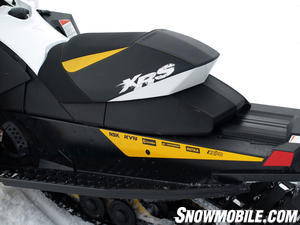 Ski-Doo XRS seating is deliberately firm with a tacky feel to the seat cover.
Ski-Doo XRS seating is deliberately firm with a tacky feel to the seat cover.
While we remembered the 600 ACE fondly from West Yellowstone, we weren’t overly impressed. That changed at sea level where the newest “family four-stroke” made us forget our favorite play sled — our personal 550 fan-cooled REV X. We’ll happily take the TNT 600 ACE any day. It is so smooth and so much fun to ride. It’s light and extremely nimble. The shock package, not expensive by any means, works just right with very little noticeable fade in even the tightest curvy sections. The eDrive gives a sense of engine braking as you let off heading into a corner, but comes back on the torque instantly as you push the throttle back in. You don’t lose the momentum and power that goes away with the fan-cooled. The TNT 600 ACE is one of the easiest sleds to ride we’ve ever been on. Heck, the Ski-Doo guy couldn’t get us to give it up. Yeah, we rode the 600 X-package in the tight and sweeping turns. It was what we expected. Yeah we cranked on the XRS throttle on the long corridor straights. But how long do you really want to risk triple digit running anyway?
If we could only have one snow toy, we found ourselves in petty lust over the TNT 600 ACE. In production form it is a totally unexpected surprise from what we rode out west months earlier. The sled will be virtually bulletproof and economical to operate year after year. We came away extremely impressed in all three actual production Ski-Doo models, but almost overwhelmed by how significantly pleased we were by the little four-stroke TNT. When Ski-Doo first informed us that there would be a small displacement, four-stroke TNT model, we kinda snickered. Well, the joke is on us. Ski-Doo got this sled totally right!
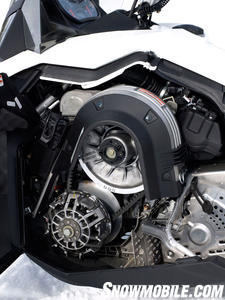 Paired with the new 600cc four-stroke twin is an extremely effective eDrive primary that came from the ATV side of BRP’s trail toys.
Paired with the new 600cc four-stroke twin is an extremely effective eDrive primary that came from the ATV side of BRP’s trail toys.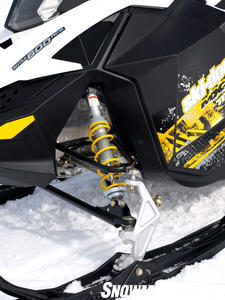 Though nothing spectacular in the way of multi-clicker or air shocks, the TNT 600 ACE front end proved up to the challenge of the tightest trails.
Though nothing spectacular in the way of multi-clicker or air shocks, the TNT 600 ACE front end proved up to the challenge of the tightest trails.When we got back to the gas station after 110 miles, we found that the new Rotax engines are not only fun on the trail but pretty good with 91-octane fuel, too. The star was the 600 ACE, averaging 20 miles per gallon even as it found its 60 horsepower engine frequently at wide open throttle to keep up with the 120-hp 600 ETEC MXZ X and the 150-ish ponies of the XRS 800 ETEC. Fuel consumption responded to horsepower ratings — the more power, the more fuel passed through. But, this was not a fuel economy run. It was an any day snowmobile ride among three friends riding out of our getaway lake cabin on trails that we knew well. In other words, it was a ride like yours if you were enjoying a Ski-Doo kind of day.



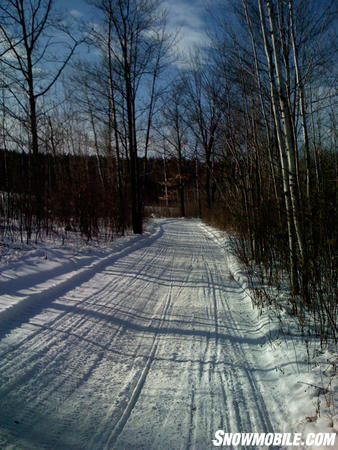
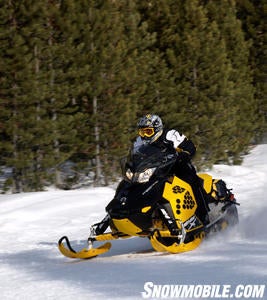
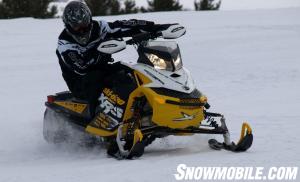
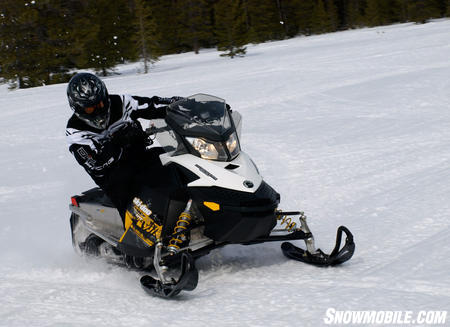
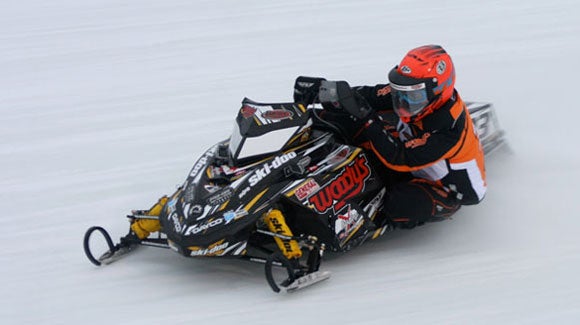
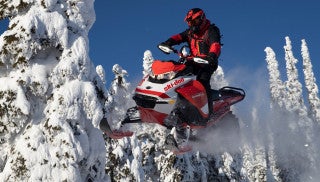



 Your Privacy Choices
Your Privacy Choices